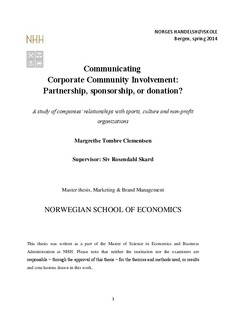Communicating Corporate Community Involvement: Partnership, sponsorship, or donation? A study of companies’ relationships with sports, culture and non-profit organizations
Master thesis
Permanent lenke
http://hdl.handle.net/11250/223251Utgivelsesdato
2014-10-07Metadata
Vis full innførselSamlinger
- Master Thesis [4372]
Sammendrag
This thesis studies how companies communicate their corporate community involvement (CCI), and how consumers’ respond to various communication strategies in this regard. Companies’ CCI may entail relationships with different organizations in the community. It is common for companies to have relationships with different organizations within sports and culture, as well as non-profit organizations. These relationships may vary according to the scope of activities and the company’s involvement. Some relationships involve simple money donations, whereas others might be close collaborations with a wider range of activities. The theoretical framework underlying the thesis is the Collaboration Continuum developed by Austin (2000a). This framework defines three relationship forms: philanthropy, sponsorships and partnerships.
The thesis consists of two empirical studies. Study 1 examines the terms companies’ apply when communicating their relationships with sports, culture and non-profit organizations. Results from the examination of secondary data (e.g. companies’ webpages) show that the communication is unsystematic. In other words, the companies apply terms related to several relationship forms regardless of their conceptual or practical meaning. For instance, companies define different sport entities as collaboration partners but also apply terms relating to sponsorship or philanthropy in the same communication.
Study 2 investigates the effects of specific relationship terms (partnership, sponsorship, and donation) on consumers’ evaluation of the relationship. This study also examines the proposed moderating effect of whether the collaborator is commercial or philanthropic. The basis of study 2 is an experiment exposing the participants to a fictitious press release. Each of the press releases denote different relationship forms (philanthropy, sponsorship or partnership) and types of collaborators (commercial or philanthropic). The results of this study show that terms applied in the communication and the type of collaborator influences consumers’ evaluations’ of the relationship.
